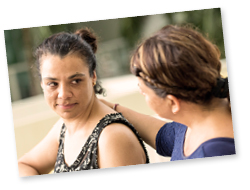
With you through life’s journey...
Whether you are about to retire, become a full-time grandparent, or start a new chapter, Social Security provides financial benefits, information, and tools to help secure today and tomorrow for you and your family.
This year about 184 million people will work and pay Social Security taxes and almost 68 million people will receive Social Security benefits on average each month.
We’re there day one

We are with you from day one, when your parents named you and when you named your children — beginning a lifetime of security. Most parents apply for their child’s Social Security number at birth, usually through the hospital. When the time comes for your kid’s first job, the number is already in place.
A fun bonus of assigning Social Security numbers at birth is that we know the most popular baby names, which we announce each year. On our website, you can find the top baby names for the last 100 years.
We’re there when you get your first job

Women have challenging choices to make. Some may spend their entire adulthood in a career or job outside the home. Some may work for a few years, leave the labor force to raise children, and eventually return to work. And some may choose not to work outside the home at all. Whether you work, have worked, or have never worked outside the home, you need to understand how Social Security can help you and your family find financial security.
Employers collect FICA, or Federal Insurance Contributions Act withholdings, and report earnings electronically to us. This is how we track your earnings and is how you earn Social Security retirement, disability, spouses, and survivors coverage for you and your family. A worker earns up to four Social Security credits each year and needs 40 credits, or 10 years of work, to be eligible for retirement benefits. It’s vital that you work at least 10 years to be eligible for Social Security based on your own work record.
Opening your personal my Social Security account allows you to verify your earnings history and see if you will get Social Security retirement benefits. Your personal my Social Security account also lets you estimate future benefits.
We’re there when you get married

Whether you’re celebrating your anniversary or starting a new chapter alone or with a new spouse, a part of that new life may include a new name. If you legally change your name due to marriage, divorce, or any other reason, let us know so you can get an updated Social Security card — and so we can accurately keep track of your earnings. There’s no charge for a Social Security card.
We’re there to help if disability strikes

Isn’t it nice to know that Social Security is here to help even if the unexpected happens?
Disability benefits provide modest coverage for severely disabled workers and their dependents, including our wounded warriors.
We’re there to provide comfort during difficult times

The loss of a loved one can be both emotionally and financially difficult. Some widows, widowers, and children may receive survivors benefits to help them cope with the financial loss. The number of credits needed to provide benefits for survivors depends on the worker’s age when he or she dies.
Unmarried children who are under age 18 (up to age 19 if attending elementary or secondary school full time) can be eligible to receive Social Security benefits when a parent dies.
We wouldn’t miss your retirement party

When most people think of Social Security, they think of retirement benefits — with good reason. We have you covered through your lifetime. Knowing you will probably be entitled to a portion of your spouse’s retirement benefits if they pass away is an added security.
Under Social Security, lower-wage earners receive a higher percentage benefit than higher-wage earners do. The system returns a greater percentage of pre-retirement earnings to a lower-wage worker than a higher-wage worker. Women who are low-wage workers receive back more benefits in relation to lifetime earnings than do high-wage earners.
Sign-in or create a personal my Social Security account to verify your earnings and see an estimate of future benefits throughout your career and into retirement.
With a personal my Social Security account, you can estimate your future benefits at different ages when you may want to start receiving benefits.
We are with those who need a helping hand…
The Supplemental Security Income (SSI) program is a program that provides income support to people with disabilities, people age 65 or older, or blind, who have low income and resources. U.S. Treasury general funds, not the Social Security trust funds, pay for SSI.
If you or someone you know may be eligible for SSI, visit SSI Benefits to learn more and apply.
And we will be there for years to come…
Social Security has two trust funds — Old-Age and Survivors Insurance (OASI) and Disability Insurance (DI). Historically, the OASI and DI Trust Funds have reached times where dedicated tax revenue fell short of the cost of providing benefits and also times where the trust funds have reached the brink of exhaustion of assets. However, Congress approved the Social Security Amendments of 1977 and 1983, which made substantial modifications that reversed the cash flow of the program to positive levels and caused the substantial buildup of assets that exists today.
Social Security has always changed to meet the needs of the people we serve and will continue to help support you and your family.